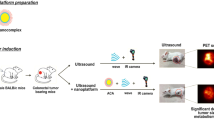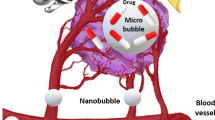Abstract
Purpose
The aim of this study was to investigate the combination effects of pulsed HIFU (pHIFU) and phase-change nanodroplets (PCND) as a sensitizer on efficient induction of mechanical effects of pHIFU and chemically enhanced tumor growth inhibition for local anti-tumor therapy.
Method
Changes in growth of colon 26 tumor tissue inoculated onto CDF1 mice were evaluated by the following treatments. (1) pHIFU exposure (1.1 MHz, 3.2 kW/cm2, 300 cycles, and 50 ms interval) for 60 s, (2) PCND (1 %) injection, (3) adriamycin (4 mg/kg) injection, (4) pHIFU exposure after PCND injection, and (5) pHIFU exposure after PCND + adriamycin injection simultaneously.
Results
Significant changes in tumor growth were observed in the group with combination of pHIFU and PCND, although single therapy did not show any significant difference. PCND enhanced mechanical tissue fractionation by pHIFU, which was detectable by Real-time tissue elastography. Moreover, the combination of pHIFU and PCND + Adriamycin suppressed the tumor growth for 2 weeks, and 3 of 4 mice did not show any sign of regrowth during the 30-day observation.
Conclusion
The combination of pHIFU and PCND exerted a significant anti-tumor effect and may be a new candidate for treatment of locally advanced cancer.











Similar content being viewed by others
References
Zhou YF. High intensity focused ultrasound in clinical tumor ablation. World J Clin Oncol. 2011;2:8–27.
Illing RO, Kennedy JE, Wu F, et al. The safety and feasibility of extracorporeal high-intensity focused ultrasound (HIFU) for the treatment of liver and kidney tumours in a Western population. Br J Cancer. 2005;93:890–5.
McDannold N, Hynynen K, Wolf D, et al. MRI evaluation of thermal ablation of tumors with focused ultrasound. J Magn Reson Imaging. 1998;8:91–100.
Xu J, Bigelow TA, Nagaraju R. Precision control of lesions by high-intensity focused ultrasound cavitation-based histotripsy through varying pulse duration. IEEE Trans Ultrason Ferroelectr Freq Control. 2013;60:1401–11.
Styn N, Hall TL, Fowlkes JB, et al. Histotripsy homogenization of the prostate: thresholds for cavitation damage of periprostatic structures. J Endourol. 2011;25:1531–5.
Xu Z, Ludomirsky A, Eun LY, et al. Controlled ultrasound tissue erosion. IEEE Trans Ultrason Ferroelectr Freq Control. 2004;51:726–36.
Roberts WW, Hall TL, Ives K, et al. Pulsed cavitational ultrasound: a noninvasive technology for controlled tissue ablation (histotripsy) in the rabbit kidney. J Urol. 2006;175:734–8.
Furusawa H, Namba K, Nakahara H, et al. The evolving non-surgical ablation of breast cancer: MR guided focused ultrasound (MRgFUS). Breast Cancer. 2007;14:55–8.
Rebillard X, Soulie M, Chartier-Kastler E, et al. High-intensity focused ultrasound in prostate cancer; a systematic literature review of the French Association of Urology. BJU Int. 2008;101:1205–13.
Rewcastle JC. High intensity focused ultrasound for prostate cancer: a review of the scientific foundation, technology and clinical outcomes. Technol Cancer Res Treat. 2006;5:619–25.
Jiang F, He M, Liu YJ, et al. High intensity focused ultrasound ablation of goat liver in vivo: pathologic changes of portal vein and the “heat-sink” effect. Ultrasonics. 2013;53:77–83.
Hall TL, Hempel CR, Wojno K, et al. Histotripsy of the prostate: dose effects in a chronic canine model. Urology. 2009;74:932–7.
Hempel CR, Hall TL, Cain CA, et al. Histotripsy fractionation of prostate tissue: local effects and systemic response in a canine model. J Urol. 2011;185:1484–9.
Schade GR, Keller J, Ives K, et al. Histotripsy focal ablation of implanted prostate tumor in an ACE-1 canine cancer model. J Urol. 2012;188:1957–64.
Lake AM, Hall TL, Kieran K, et al. Histotripsy: minimally invasive technology for prostatic tissue ablation in an in vivo canine model. Urology. 2008;72:682–6.
Miller RM, Maxwell A, Wang TY, et al. Real-time elastography-based monitoring of histotripsy tissue fractionation using color Doppler. Proc 2012 IEEE Ultrasonics Symp. 2012;196–9.
Wang TY, Hall TL, Xu Z, et al. Imaging feedback for histotripsy by characterizing dynamics of acoustic radiation force impulse (ARFI)-induced shear waves excited in a treated volume. IEEE Trans Ultrason Ferroelectr Freq Control. 2014;61:1137–51.
Wang YN, Khokhlova T, Bailey M, et al. Histological and biochemical analysis of mechanical and thermal bioeffects in boiling histotripsy lesions induced by high intensity focused ultrasound. Ultrasound Med Biol. 2013;39:424–38.
Maxwell AD, Cain CA, Duryea AP, et al. Noninvasive thrombolysis using pulsed ultrasound cavitation therapy—histotripsy. Ultrasound Med Biol. 2009;35:1982–94.
Kawabata K, Maruoka T, Asami R, et al. Controlled induction of mechanical bioeffects with pulsed ultrasound and chemical agents. Proc 2013 IEEE Ultrasonics Symp. 2013;2106–9.
Kawabata K, Maruoka T, Asami R, et al. Acousto-chemical manipulation of drug distribution: in vitro study of new drug delivery system. Jpn J Appl Phys. 2014;53:07KF28.
Kawabata K, Sugita N, Yoshikawa H, et al. Nanoparticles with multiple perfluorocarbons for controllable ultrasonically induced phase shifting. Jpn J Appl Phys. 2005;44:4548–52.
Kawabata K, Maruoka T, Asami R, et al. Phase change nanodroplets and microbubbles generated from them as sources of chemically active cavitation. Jpn J Appl Phys. 2011;50:07HE06.
Asami R, Ikeda T, Azuma T, et al. Acoustic signal characterization of phase change nanodroplets in tissue-mimicking phantom gels. Jpn J Appl Phys. 2010;49:07HF16.
Watanabe Y, Aoi A, Horie S, et al. Low-intensity ultrasound and microbubbles enhance the antitumor effect of cisplatin. Cancer Sci. 2008;99:2525–31.
Yumita N, Nishigaki R, Umemura S. Sonodynamically induced antitumor effect of Photofrin II on colon 26 carcinoma. J Cancer Res Clin Oncol. 2000;126:601–6.
Shanei A, Sazgarnia A, Meibodi NT, et al. Sonodynamic therapy using protoporphyrin ix conjugated to gold nanoparticles: an in vivo study on a colon tumor model. Iran J Basic Med Sci. 2012;15:759–67.
Wang TY, Xu Z, Winterroth F, et al. Quantitative ultrasound backscatter for pulsed cavitational ultrasound therapy—histotripsy. IEEE Trans Ultrason Ferroelectr Freq Control. 2009;56:995–1005.
Kang ST, Lin YC, Yeh CK. Mechanical bioeffects of acoustic droplet vaporization in vessel-mimicking phantoms. Ultrason Sonochem. 2014;21:1866–74.
Liberman A, Wu Z, Barback CV, et al. Hollow iron-silica nanoshells for enhanced high intensity focused ultrasound. J Surg Res. 2014;190:391–8.
Vlaisavljevich E, Durmaz YY, Maxwell A, et al. Nanodroplet-mediated histotripsy for image-guided targeted ultrasound cell ablation. Theranostics. 2013;3:851–64.
Dwivedi A, Sengottayan V, Goel A. A minimally invasive non-thermal ablative modality for prostate: histotripsy. Indian J Urol. 2010;26:465–6.
Vlaisavljevich E, Kim Y, Owens G, et al. Effects of tissue mechanical properties on susceptibility to histotripsy-induced tissue damage. Phys Med Biol. 2014;59:253–70.
Acknowledgments
This work was supported in part by the Research and Development Committee Program of the Japan Society of Ultrasound in Medicine and Biology, and also by the Japan Society for the Promotion of Science (JSPS) through the “Funding Program for World-Leading Innovative R&D on Science and Technology (FIRST Program),” initiated by the Council for Science and Technology Policy (CSTP). The authors deeply thank Prof. Umemura of Tohoku University for discussion and encouragement.
Conflict of interest
Reiko Ashida, Ken-ichi Kawabata, Takashi Maruoka, Rei Asami, Hideki Yoshikawa, Rena Takakura, Tastuya Ioka, Kazuhiro Katayama, and Sachiko Tanaka declare that they have no conflict of interest.
Ethical consideration
All institutional and national guidelines for the care and use of laboratory animals were followed.
Author information
Authors and Affiliations
Corresponding author
About this article
Cite this article
Ashida, R., Kawabata, Ki., Maruoka, T. et al. New approach for local cancer treatment using pulsed high-intensity focused ultrasound and phase-change nanodroplets. J Med Ultrasonics 42, 457–466 (2015). https://doi.org/10.1007/s10396-015-0634-4
Received:
Accepted:
Published:
Issue Date:
DOI: https://doi.org/10.1007/s10396-015-0634-4




